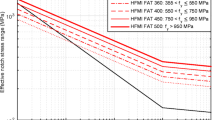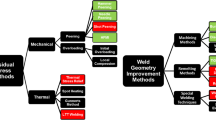Abstract
High-frequency mechanical impact (HFMI) has emerged as a reliable, effective, and user-friendly method for post-weld fatigue strength improvement technique for welded structures. During the past decade, 46 documents on HFMI technology for fatigue improvements have been presented within Commission XIII of the International Institute of Welding (IIW). This paper presents an overview of the lessons learned concerning appropriate HFMI procedures and quality assurance measures. Due to differences in HFMI tools and the wide variety of potential applications, certain details of proper treatment procedures and quantitative quality control measures are presented generally. Specific details should be documented in an HFMI procedure specification for each structure being treated. It is hoped that this guideline will provide a stimulus to researchers working in the field to test and constructively criticize the proposals made with the goal of developing international guidelines relevant to a variety of HFMI technologies and applicable to many industrial sectors. A companion document presents a fatigue design proposal for HFMI treatment of welded steel structures. The proposal is considered to apply to steel structures of plate thicknesses of 5 to 50 mm and for yield strengths ranging from 235 to 960 MPa. Stress assessment may be based on nominal stress, structural hot spot stress, or effective notch stress.











Similar content being viewed by others
References
Haagensen PJ, Maddox SJ (2012) IIW recommendations on post weld fatigue life improvement of steel and aluminium structures. Woodhead Publishing Ltd., Cambridge
Marquis GB, Mikkola E, Yildirim HC, Barsoum Z (2013) Fatigue strength improvement of steel structures by HFMI: proposed fatigue assessment guidelines. International Institute of Welding, Paris, IIW Document XIII-2452r1-13
Statnikov ES, Shevtsov UM, Kulikov VF (1977) Ultrasonic impact tool for welds strengthening and reduction of residual stresses. Publ Sci Works: Metall SEVMASH, USSR 92:27–28 (in Russian)
Kudryavtsev YF, Trufyakov VI, Mikheev PP, Statnikov EF, Burenko AG, Dobykina EK (1994) Increasing the fatigue strength of welded joints in cyclic compression. International Institute of Welding, Paris, Document XIII-1596-94
Applied Ultrasonics. In: http://www.appliedultrasonics.com/.
Integrity Testing Laboratory Inc. In: http://itlinc.com/.
Lets Global. In: http://www.lets-global.com/.
Huo L, Wang D, Zhang Y (2005) Investigation of the fatigue behaviour of the welded joints treated by TIG dressing and ultrasonic peening under variable-amplitude load. Int J Fatigue 27:95–101
Pfeifer. In: http://www.pfeifer.de/.
Pitec. In: http://www.pitec-gmbh.com/.
Sonats. In: http://www.sonats-et.com/.
Bousseau M, Millot T (2006) Fatigue life improvement of welded structures by UNP compared to TIG dressing. International Institute of Welding, Paris, Document XIII-2125-06
Pedersen M, Mouritsen OØ, Hansen M, Andersen JG, Wenderby J (2009) Comparison of post weld treatment of high strength steel welded joints in medium cycle fatigue. Weld World 54:208–217
Marquis, G., Björk, T.: Variable amplitude fatigue strength of improved HSS welds. International Institute of Welding, IIW Document XIII-2224-08, (2008)
Yildirim HC, Marquis GB (2013) A Round Robin study of high frequency mechanical impact treated welded joints subjected to variable amplitude loading. Weld World 57(3):437–447
Yildirim HC, Marquis GB (2012) Fatigue strength improvement factors for high strength steel welded joints treated by high frequency mechanical impact. Int J Fatigue 44:168–176
Yildirim HC, Marquis GB (2012) Overview of Fatigue data for high frequency mechanical impact treated welded joints. Weld World 57(7/8):82–96
Statnikov ES, Korostel V, Vekshin N, Marquis G (2006) Development of Esonix ultrasonic impact treatment techniques. International Institute of Welding, Paris, IIW Document XIII-2098-06
Lopez Martinez L, Haagensen PJ (2006) Life extension of Class F and Class F2 details using ultrasonic peening. International Institute of Welding, Paris, IIW Document XIII-2143-06
ISO 5817:2006; Welding—fusion-welded joints in steel, nickel, titanium and their alloys (beam welding excluded)—quality levels for imperfections, 2006.
Neher, M., HiFIT. presentation to the IIW Commission XIII intermediate meeting, Espoo, Finland 15-16 March, 2012.
Ultrasonics A (2006) Esonix UIT application guide: Post weld treatment for fatigue enhancement carbon steel welded structures. Alabama, USA
AASHTO LRFD bridge construction specifications (2010) Chapter 11.9 ultrasonic impact treatment, 3rd edn. American association of state highway and transportation officials, Washington, DC
Roy S, Fisher JW, Yen BT (2005) Post-weld enhancement in fatigue strength of transverse stiffeners and cover-plates using ultrasonic impact treatment (UIT), draft report of FHWA. ATLSS Engineering Research Center, Lehigh University, Bethlehem, PA
Roy S, Fisher JW (2005) Enhancing fatigue strength by ultrasonic impact treatment. Int J Steel Struct 5:241–252
AASHTO LFRD bridge design specifications, 4th edition. American association of state highway and transportation officials, Washington, D.C., 2008.
Le Quilliec G et al (2011) Fatigue behaviour of welded joints treated by high frequency hammering: Part 1. Experimental study International Institute of Welding, Paris, IIW Document XIII-2394-11
Marquis G (2010) Failure modes and fatigue strength of improved HSS welds. Eng Fract Mech 77(11):2051–2062
Yekta RT, Walbridge S (2012) Acceptance criteria for ultrasonic impact treatment (UIT), Ontario Ministry of Transportation, Report HIIFP-110. St. Catherines, Ontario, Canada
Tilly GP, Jackson PA, Maddox SJ, Henderson R (2010) Proc ICE Bridg Eng 163(3):147–152
Kudryavtsev Y, Kleiman J, Lugovskoy A, Lobanov L, Knysh V, Voitenko O (2004) Fatigue life improvement of welded elements by ultrasonic peening. International Institute of Welding, Paris, IIW Document XIII-2010-04
PIT 10 Almen test: PIT equipment calibration procedures, PITEC GmbH, Heudorf, Germany, 6 pages, 2011.
Acknowledgments
Support for this work has been partially provided by the LIGHT research program of the Finnish Metals and Engineering Competence Cluster, the Finnish Funding Agency for Technology and Innovation, and the European Union’s Research Fund for Coal and Steel Research Programme under grant agreement no RFSR-CT-2010-00032: “Improving the fatigue life of high strength steel welded structures by post weld treatments and specific filler material.” Cooperation with HFMI companies Pfeifer Seil- und Hebetechnik GmbH, Germany; Structural Integrity Technologies Inc., Canada; LETS Global AB, Sweden, Applied Ultrasonics, the Netherlands; and PITEC GmbH, Germany are acknowledged.
Author information
Authors and Affiliations
Corresponding author
Additional information
Doc. IIW-2395, recommended for publication by Commission XIII “Fatigue of Welded Components and Structures.”
Rights and permissions
About this article
Cite this article
Marquis, G., Barsoum, Z. Fatigue strength improvement of steel structures by high-frequency mechanical impact: proposed procedures and quality assurance guidelines. Weld World 58, 19–28 (2014). https://doi.org/10.1007/s40194-013-0077-8
Received:
Accepted:
Published:
Issue Date:
DOI: https://doi.org/10.1007/s40194-013-0077-8




